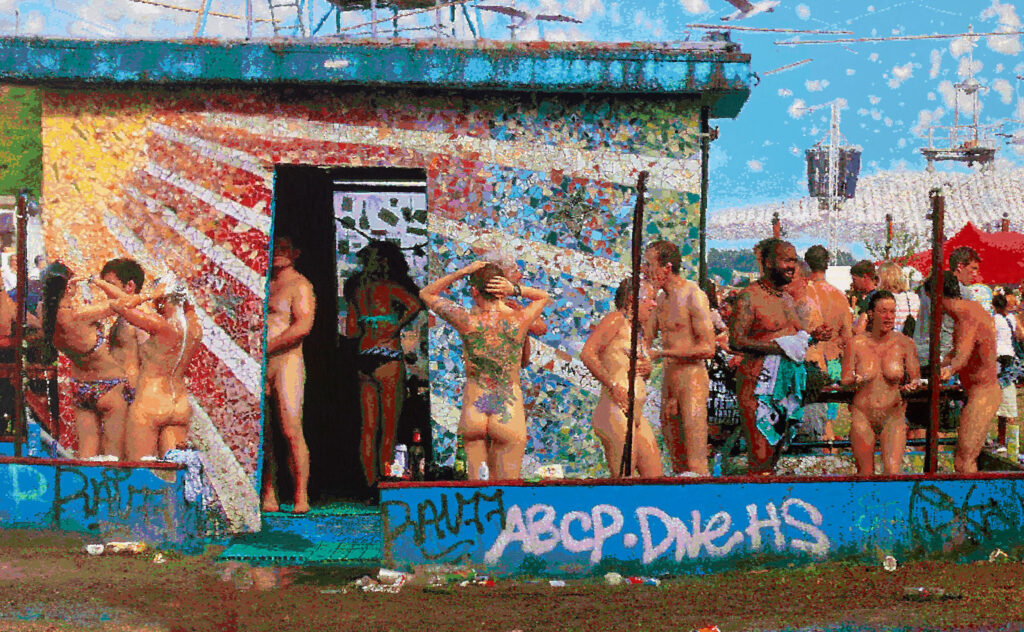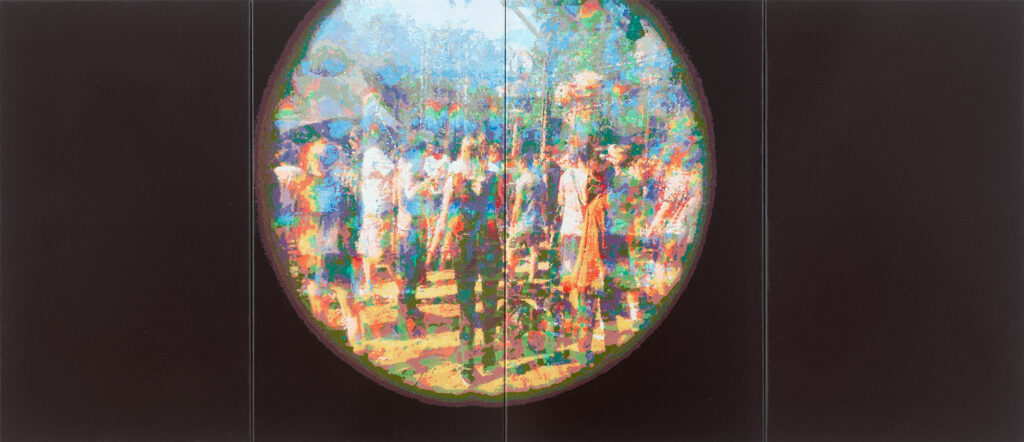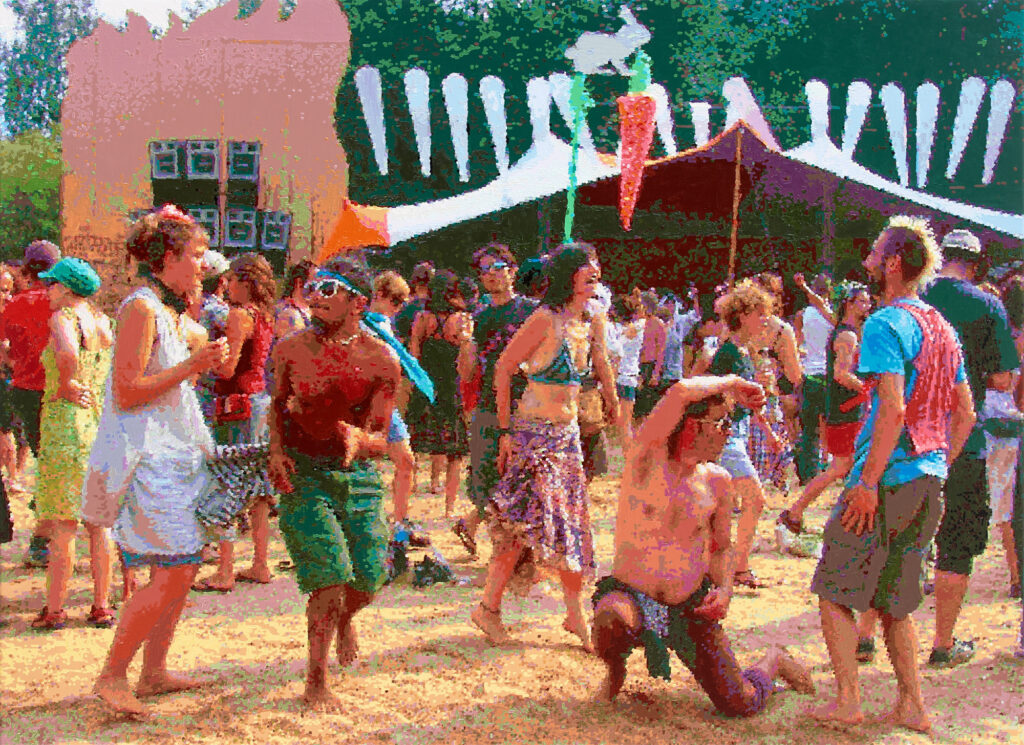The 3D post-impressionist artist duo is here and I had the chance to interview them for the first time for Azucar. The artist couple and duo Römer + Römer (or else Torsten Römer and Nina Römer) welcomed me in their studio for a tet-a-tet interview which disclosed a lot about their lives, careers and aspirations.

Credit: Ufuk Devrim Ucta
Info on the duo: Torsten Römer (b. 1968 in Aachen) and Nina Römer (b.1978 as Nina Tangian in Moscow ) studied painting at the Düsseldorf College of Arts until 2003. Both later became master class students with A.R. Penck. Since 1998 they have worked as an artist couple on joint projects and artworks. Their interest in various societal systems, people and ethnic backgrounds is not only reflected in their oeuvre, but also in their travels, performances and actions in public spaces.
Their artistic CV charts multiple solo and group exhibitions across Germany and abroad, among others, at the Today Art Museum in Beijing, at Freight+Volume Gallery in New York, at the Palais de Tokyo in Paris, the Korean Gwangju Art Museum, Heidelberger Kunstverein, Kunsthalle Rostock, Künstlerhaus Wien, the Wilhelm-Hack-Museum in Ludwigshafen, the Museum für Angewandte Kunst in Frankfurt or the Venice Biennale (56th Biennale, 2015).
Currently runnig shows are a solo exhibition in Kunstverein Münsterland and the group exhibitions „Surf“ at Galerie Hartwich and „Kuss“ in Bröhan Museum, Berlin.
Below the interview.
Vanessa for Azucar Magazine:
First of all, thank you for accepting to do this interview. I would like to start by asking you when you started doing art both officially and unofficially so to say, which point you consider the beginning of your career and at which point you started working together.
Römer + Römer:
That happened more or less at the same time. In the beginning we had a different way, then we moved to Cologne and started painting together and then doing some projects together.
When we met, we painted quite differently; I (Torsten) was more of an abstract painter, Nina was more of a figurative painter. After we met, we were exhibiting our works separately for some time but then we started painting together and cooperating. For almost, half a year the cooperation wasn’t definite, sometimes we worked together and sometimes not. But at some point we started making projects and performances together signing with the same name as Römer & Römer.
Vanessa:
(Question to Nina) How do you feel about the fact, that you changed your name? Does it make a difference to your identity as an artist or as a person?
Nina Römer:
I think it’s good to change the name. I don’t know why but many artists don’t want to change their names. I am wondering why often artists have such boring names and they don’t change them (laughter). It also started to look a bit funny, the same name double. We thought about different ideas but this name came as our final decision.
Vanessa:
How would you describe the experience of working together as an artist duo?
Römer + Römer:
I think it’s much nicer because I didn’t like it so much to work alone, like a genius artist. I think that being an artist is about communication not only about working together but generally about people coming together in exhibiting. We value communication as something very important.
Vanessa:
This might be a cheesy question but don’t you ever fight about what you want to do in a painting? More like having different directions?
Römer + Römer:
In the beginning it was more complicated, we had a lot more fights because we had the illusion of losing our individuality but after one year it was getting very simple. When we started working together many people told us “be careful, you will destroy each other”. When we discuss new work, we try to communicate in a way that’s constructive. In the beginning it was different because we worked on the same paintings on different times so it was like destroying something that the other person had done. I think it’s easier if you work as a couple or with a relative, otherwise if you don’t know the person well enough you might think that they are using you or something. Also, when we are only two people working on the same work, we both want to be happy with it; it’s not like in works with many artists where nobody wants to feel responsible for it.
Vanessa:
What is the difference when you create a work and when you curate some other people’s works?
Römer + Römer:
When we curate shows, we always try to find the best works of the artists; when you have many good works from many interesting artists, then you have a really good show.
We are not curating very ‘straight’, I think we have more like a discussion with the artists, more like a communication process about which works they would like to exhibit etc. I think the whole process of coming to the idea of an exhibition comes through communication. It’s not like being a curator curator, but more like seeing yourself as an artist and communicator, sometimes you are responsible but in the end people should be happy with it.
In the beginning we didn’t use the word curator, but the word initiator. Back then the notion of curator was not so popular. Nowadays, it’s more normal that artists curate their shows, but when we started it was not usual that artists curate exhibitions. By letting artists curate their shows you give artists more responsibility, you are not in the background for creating the show or the art fair but you give the artists more power to decide what they want to do.
Vanessa:
And how many shows have you curated?
Römer + Römer:
We curated around 10 bigger shows, most of them under the project name M°A°I°S. As a side project of M.A.I.S V (2003) they gave us an S-bahn to do whatever we wanted with it and then we had the idea to paint it white and write on it ‘Paradies’ which was the name of the project. That was our biggest curated show with 200 artists, different events, poetry readings, parties and a baroque festival – and we made this all on our own. 15.000 people came. Plus, we did everything on a low budget, we even cleaned up the place on our own.
After this project, from 2005 onwards, we focused more on our own projects because we were too focused on big things and somehow we didn’t want to become professional curators. Our projects are always like curating together with artists but sometimes people expect from you that you are like the curator and so we had to do a break . . The most recent project “Under Construction” was in January this year. Our last personal project is the Kissing Performance which we first did 2003 as German-Russian Kissing Performance and now repeated in a different way as Postfactual Kissing Performance
Vanessa:
How would you describe your position in the contemporary art world? Do you see your position as a Berlin based artist or more international?
Römer + Römer:
Berlin is getting more and more international. We lived here in 2000 and at this time Berlin wasn’t so international. We were always interested in having international inputs in our art but with Berlin we are quite happy. Also, the system of the galleries is changing; the art scene is so international, the internet is stronger, the art fairs are stronger. When you work professionally as an artist, you have to be more and more international and I think it’s not any longer static as it was for example in the 60s in Germany. Now everything is more; more artists, more collectors more art fairs.

„Shower Tower Oase“, 2014, oil on canvas, 200 x 750 cm (triptych, detail)
Credit: Eric Tschernow
Vanessa:
. . . but the capital is getting less. More of everything, but less money in the art sector.
Römer + Römer:
Maybe we have too many of these fairs, it should be shrinking a bit. The most interesting for me (Torsten) is to look at solo shows of artists. When the artist only produces for art fairs, then the work is not that good as in the solo show; in the art fair, you focus more on the commercial side and the work is getting very little attention, but when you have a solo show, you can have a much more different atmosphere and for me it’s much more interesting. When artists are too much into the commercial side of art, they don’t have time to create new ideas and to experiment.
Vanessa:
That was very interesting. Would you like to add something more?
Römer + Römer:
For me (Torsten) it would be interesting to mention that in our art, we use themes which we keep for a few years. For example, the actual theme we had for nearly three years was about the Fusion Festival and before we had the Carnival in Brazil for two years… everything we paint is based on photographs of events we experienced. So we don’t use materials from the internet etc but we are part of the whole scene that we paint.

„Spotlight“, 2017, Öl auf Leinwand, 95 x 220 cm
Credit: Eric Tschernow
„Tanz auf der Seebühne“, 2015, oil on canvas, 110 x 150 cm
Credit: Eric Tschernow
Vanessa:
For me it looks like you are inspired by something very ephemeral, like a festival which lasts three days, five days, one week and then you work on this ephemeral thing for years, which is quite interesting. More like that you have the moment and you expand it into something that stays.
Römer + Römer:
Yes. Our next project will be about the famous Burning Man festival, which takes place in the desert of Nevada, USA. We are looking forward to travel there in the end of August. Afterwards we will work on a painting cycle about Burning Man, which will be shown in a solo show in Haus am Lützowplatz, Berlin, in January 2019.
For further information, visit www.roemer.tv.

